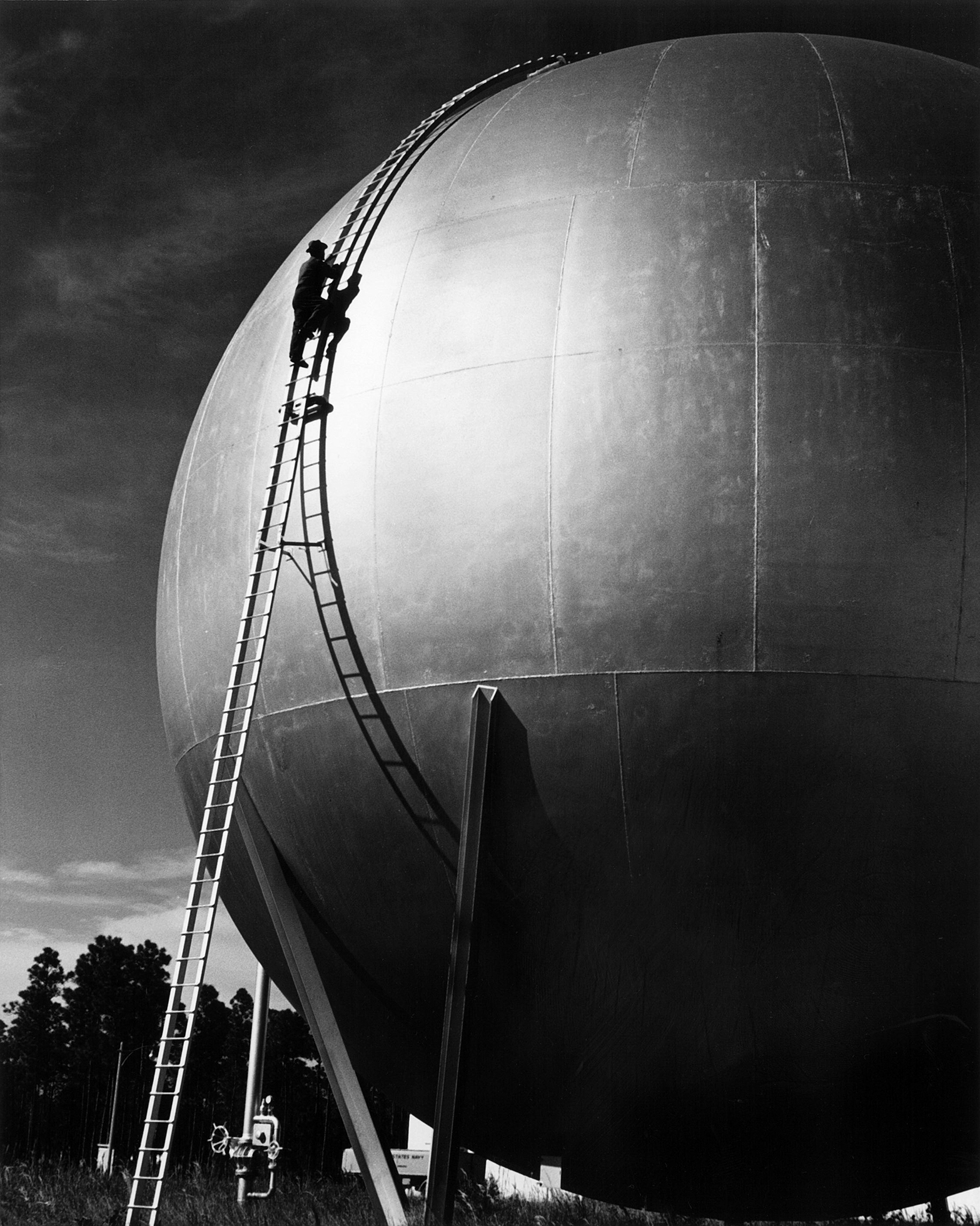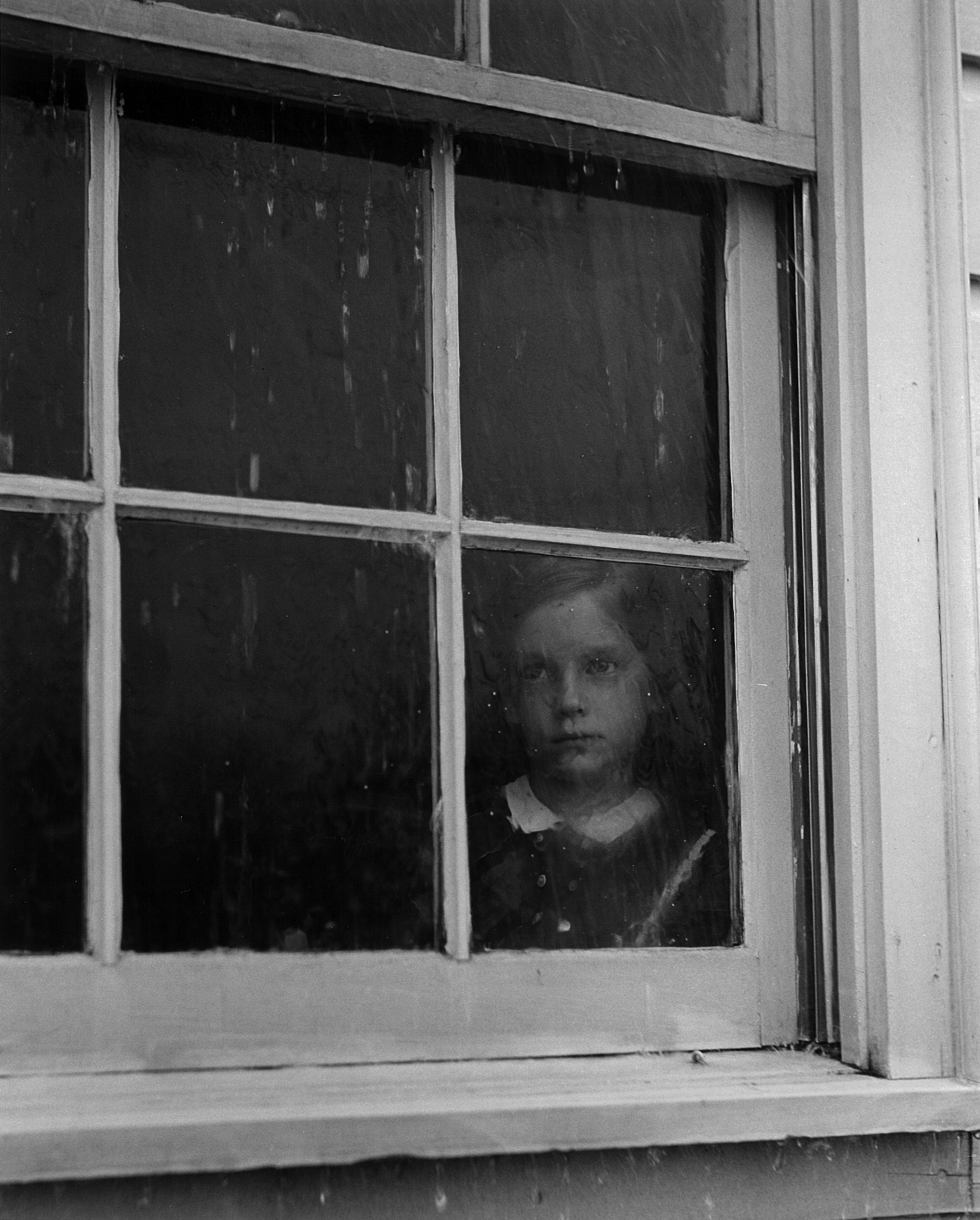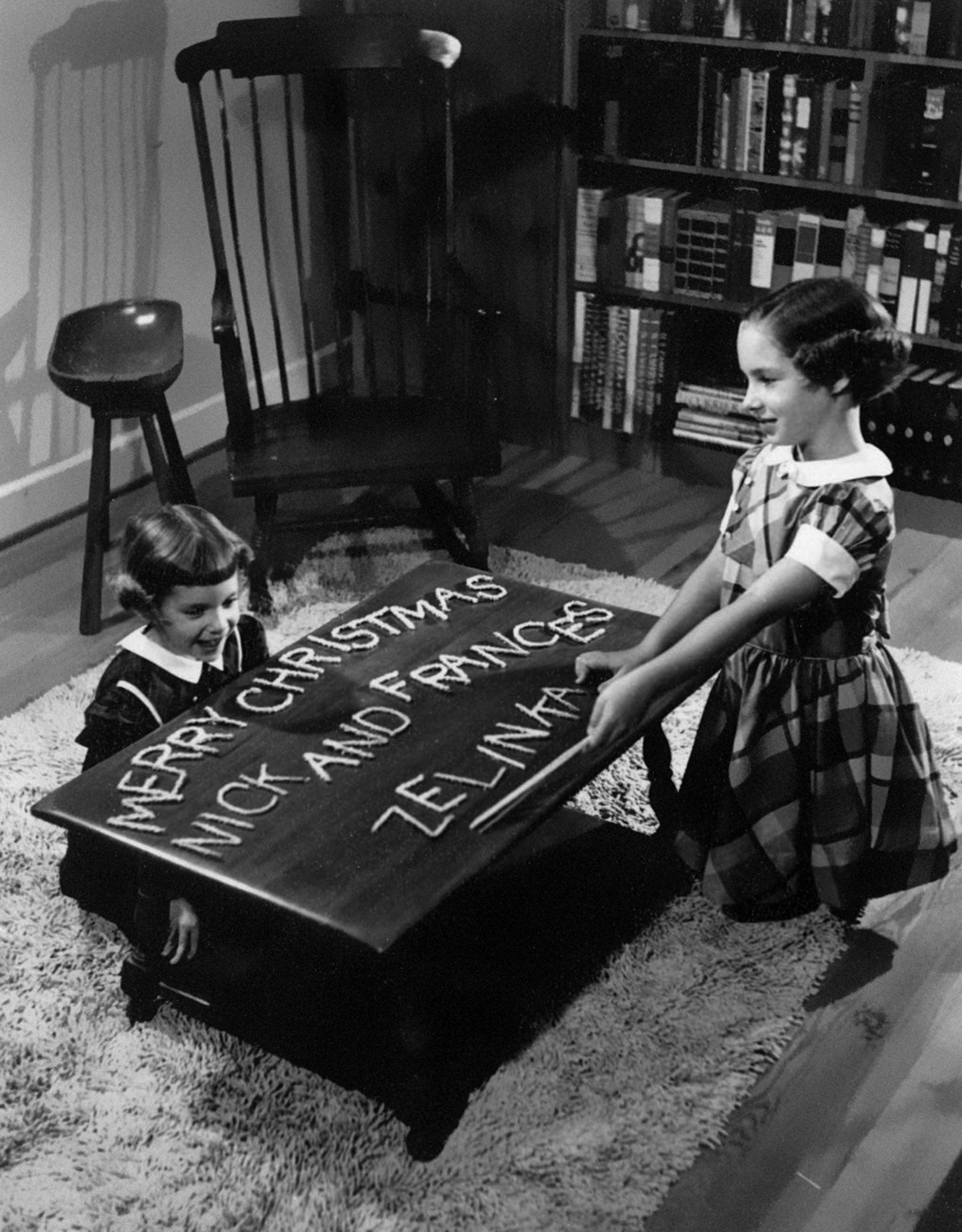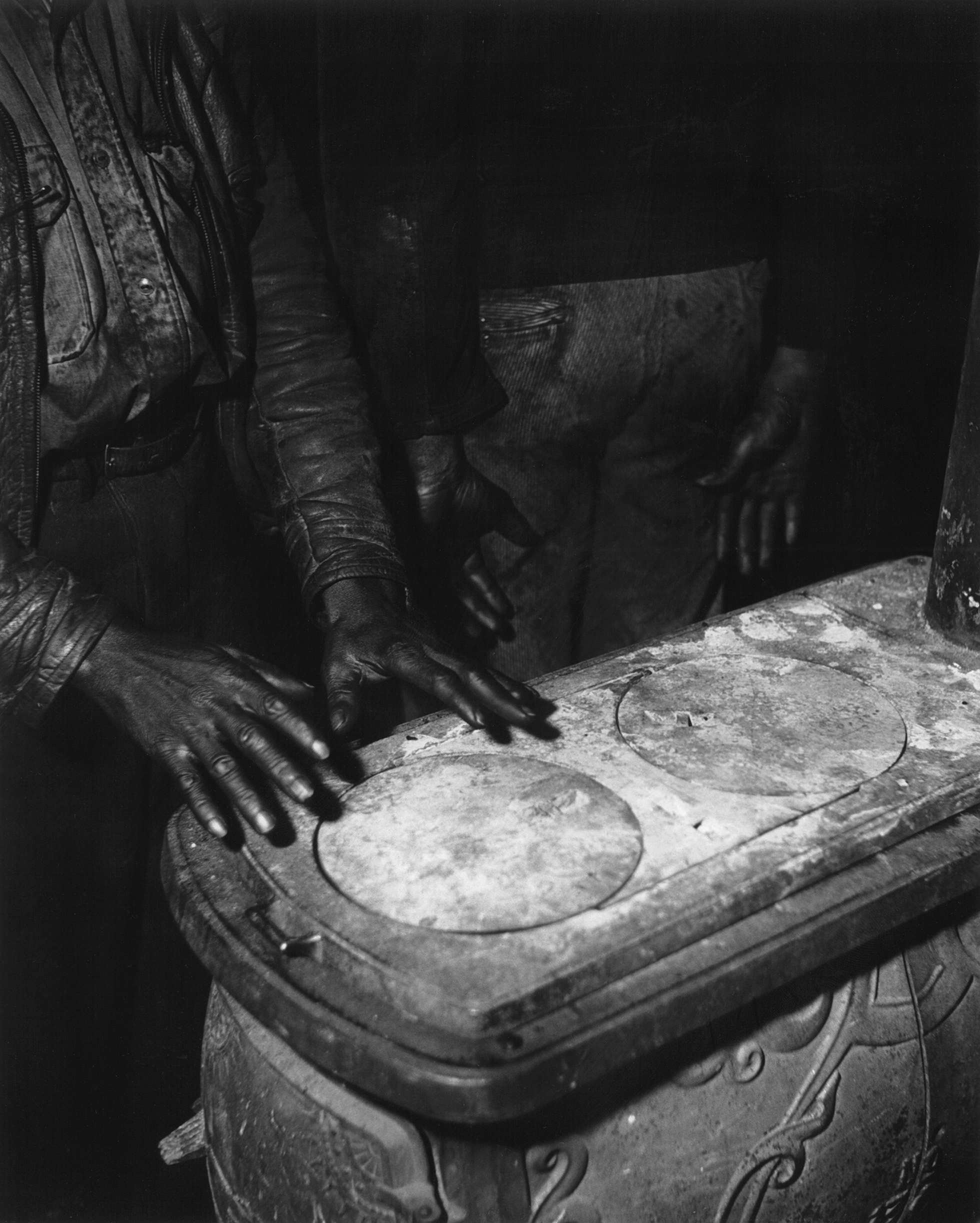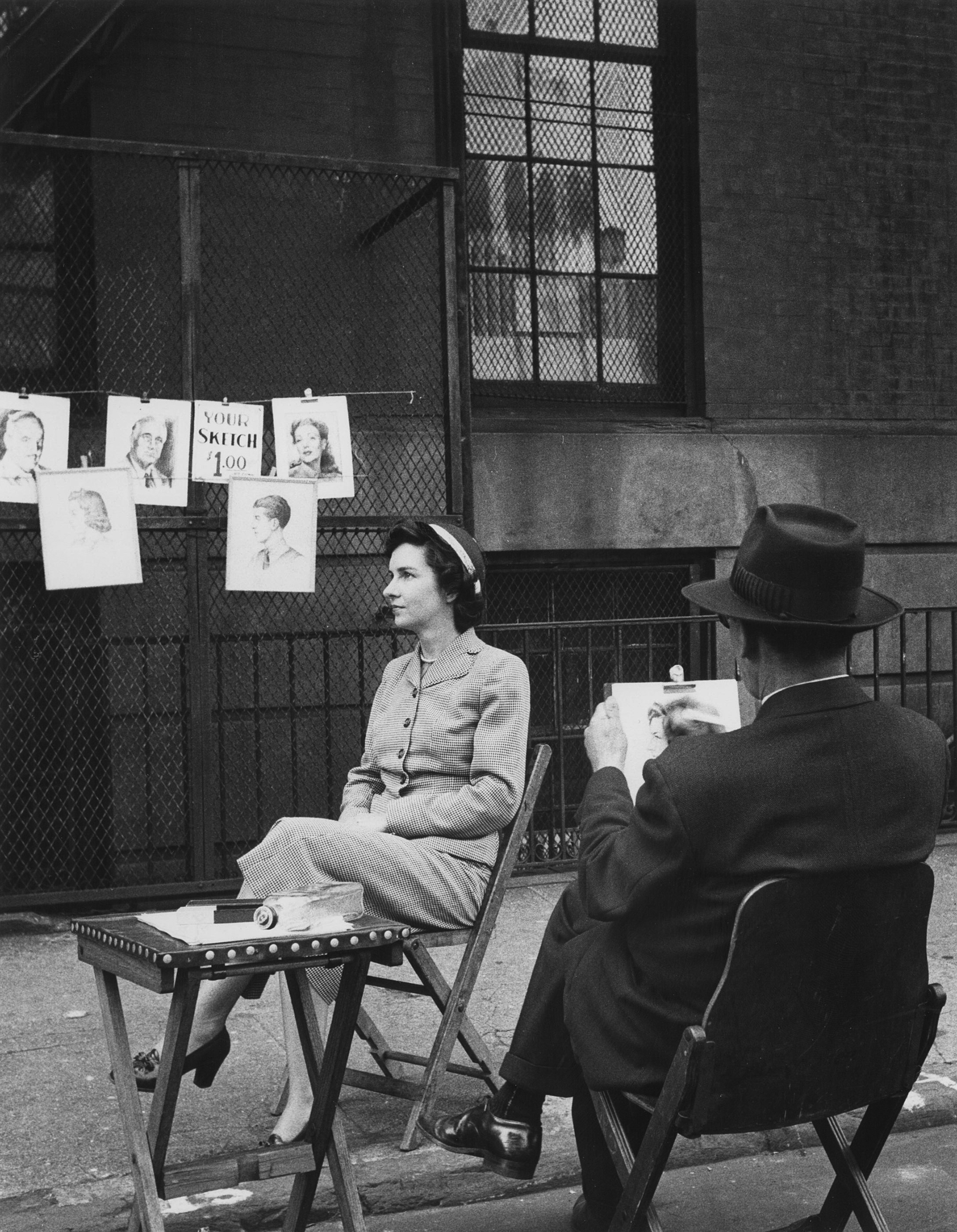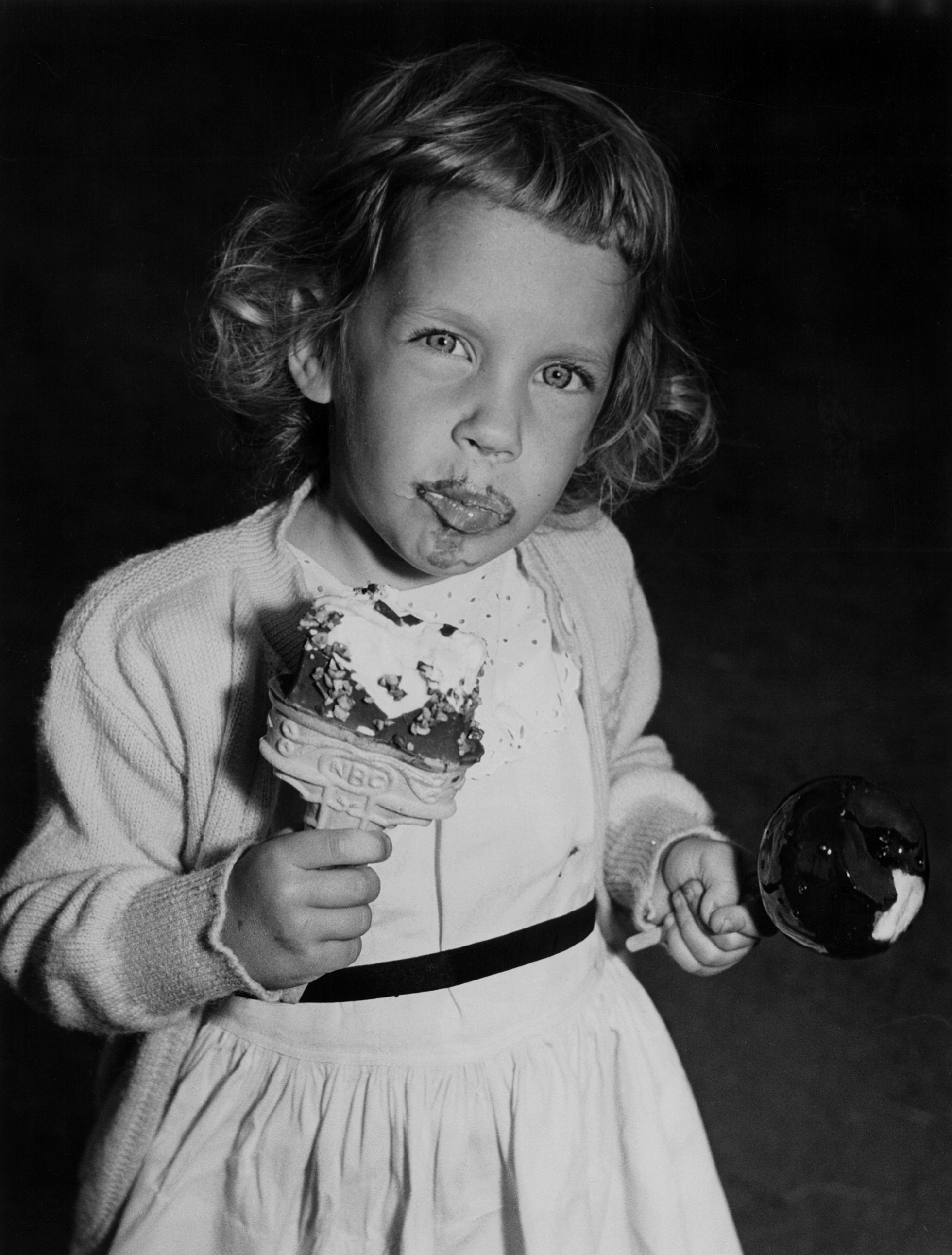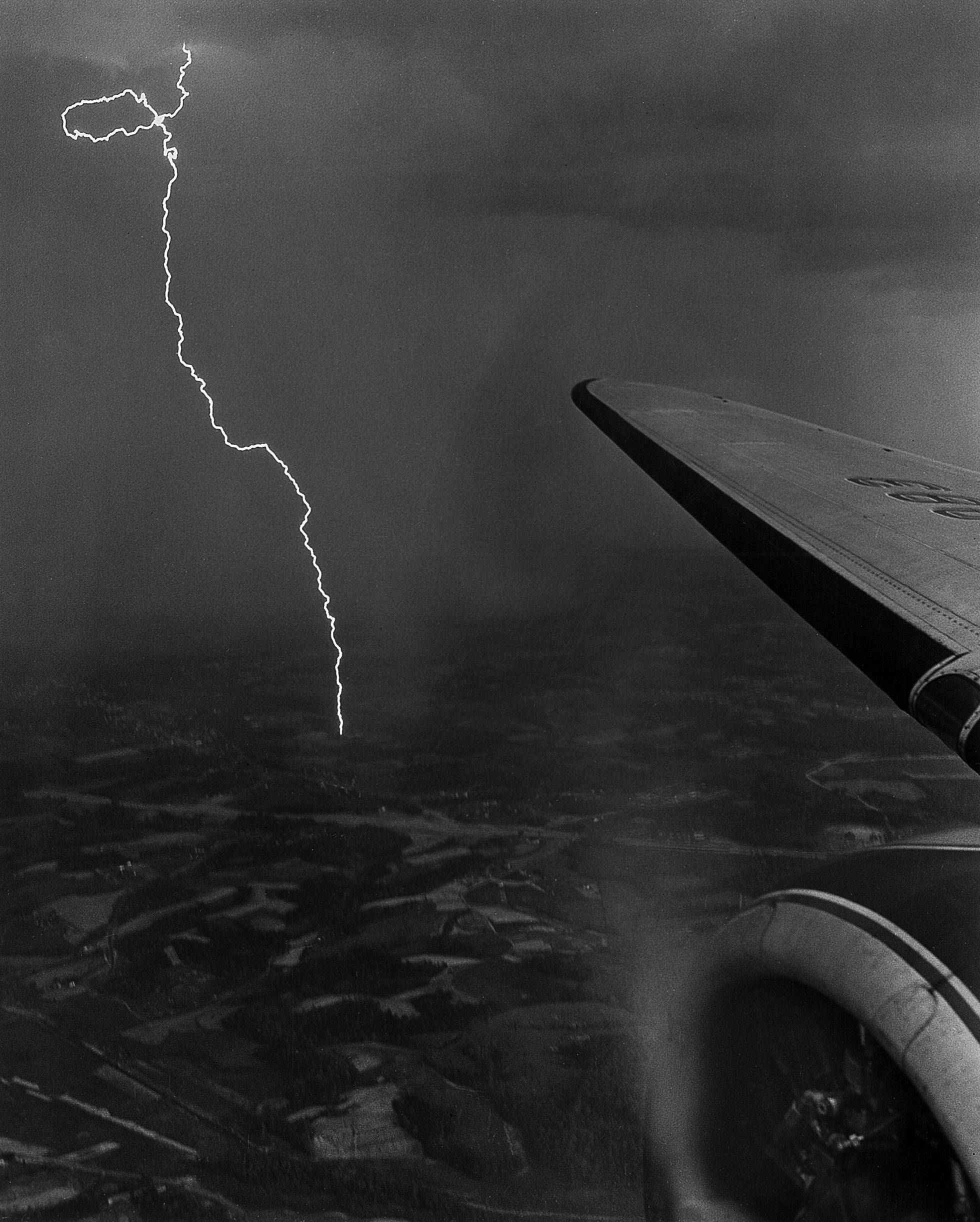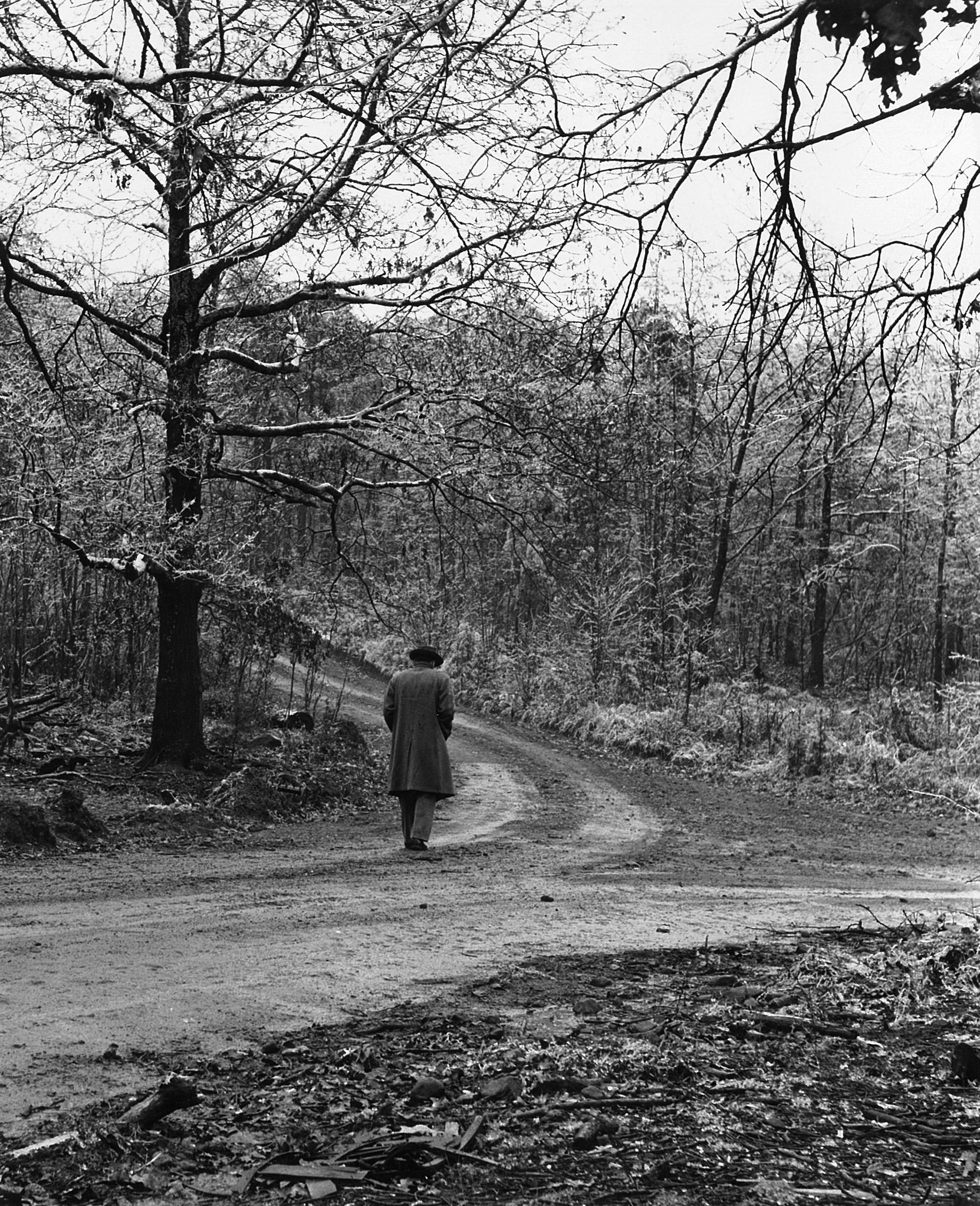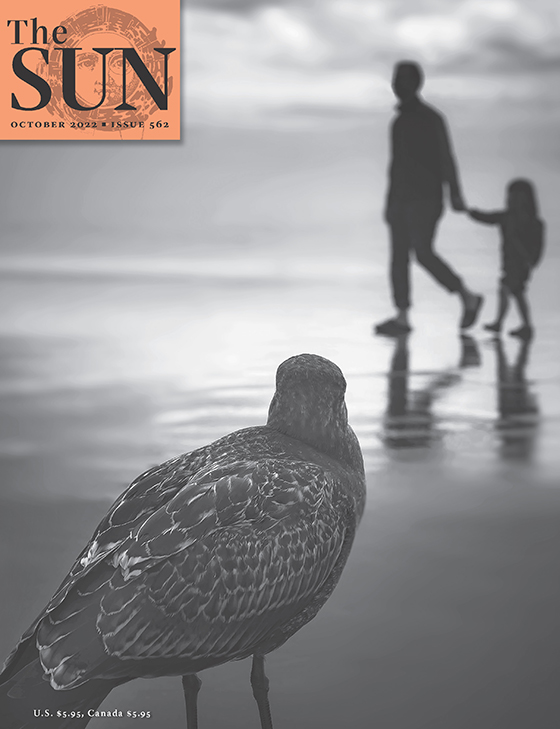Each section of this memoir is inspired by a photograph taken by the author’s father. The titles inside quotation marks are those her father gave the accompanying images. The other pictures were all originally untitled.
— Ed.
Water Tower (featured above)
Photography suited my father, loner that he was. He’d come home from his job as an airline pilot, give Mother a peck on the cheek before changing out of his uniform, and drive off again with at least one of his three Rolleiflex cameras. When I was a child growing up in North Carolina during the early fifties, he’d acknowledge me only if I was in his direct path. “Go on now, Mary Helen. I’m in a hurry,” he was likely to say.
Father kept an old trench coat and a felt hat in the trunk of his Ford in case he discovered a scene that needed a human figure. With the tripod and timer, he could be both the image-maker and part of the image.
If the pose he wanted required longer than his timer allowed, he’d pack up my siblings and Mother and me so that she could snap the shutter for him. He’d set the camera on the tripod, peer through the lens, and explain to her over and over exactly what to do.
One time he pulled on some overalls over his regular clothes, tugged his felt hat down over his forehead, and climbed halfway up a water tower. I was an adult before I found out that he was terrified of heights. He would do anything to get a good picture.
“Rain, Rain, Go Away”
There are no amateur snapshots of my childhood — no blurry, off-center pictures of me blowing out birthday candles, faded writing on the reverse: “Mary Helen, age four.” Instead I have eight-by-ten black-and-white photographs with my father’s stamp on the back of each: “Photograph by N. Zelinka.”
Once, I asked Mother why Father had photographed me so much. Why not my older sister, Gracie? Or my brother, Charles, born five years after me? “Because you looked like you didn’t belong to anyone,” she said. “Gracie was too pretty; you made the better story.”
The little girl in my pile of eight-by-tens is a stranger to me; but I do remember posing for this photograph taken in the rain.
It wasn’t really raining that day. I watched from the dining room as Mother, standing outside next to Father, sprayed the house with the hose.
“Don’t look at me!” Father yelled through the window. “Look at the sandbox!” Then, turning on Mother, he shouted, “Get in there and put her shoulder against the window frame!”
Mother set down the hose, but Father had already stomped past her.
He came inside and shoved me against the window ledge. “Don’t move!” Mother picked up the hose again. I stared at the sandbox.
My father knew how light and shadow cast moods and tell stories. He knew where the subject should stand and where to focus his lens. He knew the expression he wanted on his subject’s face and how to get it.
Christmas Card 1951
Long after I left home, Mother sent me a complete set of the Zelinka Christmas cards. Just touching the box made my heart beat faster. Without opening it, I locked it in my trunk, along with the other ghosts of my past.
The making of the annual Christmas card was an important event. My father composed the picture and shot as many rolls of film as he thought necessary. He and Mother then pored over the contact sheets with magnifying glasses. The chosen photo was made into dozens of four-by-fives. Mother wrote notes on the back of them, stuck them in envelopes, and mailed them out to all my father’s photography and airline friends. Stacks of pictures and envelopes and sheets of stamps covered the dining-room table for days. Gracie and I had to lick the envelopes and stamps.
The making of the 1951 picture took all day. In the morning Mother curled Gracie’s and my hair, pinching it to our heads with bobby pins. (Charles wasn’t born yet.) Then she dusted and vacuumed the living room and arranged the furniture to Father’s specifications. Later in the afternoon my sister and I took baths, and Mother brushed our curls. We dressed up in our church dresses while Father set up his lights and placed the props just so.
Gracie knelt on the opposite side of the coffee table from me and aimed the pointer at the pipe-cleaner letter Z, as Father instructed. She looked so unfamiliar in her curls that I giggled.
“Mary Helen!” Father shouted.
I stopped laughing.
“Smile,” Father said. “Look at the letter where Gracie is pointing.”
I smiled at the letter Z.
“Sit up! Stop slouching!”
I straightened up.
“Don’t put your hand by the table leg like that! Keep it in your lap!”
I moved my hand to my lap. Gracie kept pointing at the letter Z, not moving a muscle.
“Smile!”
Days later Father and Mother sat at the dining-room table reviewing the contact sheets. “Look at her hand! She’s ruined every single one!”
I made myself small against the doorway and hugged the wall as I crept back into my bedroom.
“We could redo them,” I heard Mother say.
“There’s not enough time. We’ll just have to send one of these. I told her to move her hand!”
Cotton Farmer
Whenever my father had a layover on one of his trips, he spent his time taking pictures. One day, while roaming the outskirts of Charleston, South Carolina, he talked to a black man who worked a small cotton field. My father returned to the man’s farm many times and was eventually invited into the home the man shared with his grown son.
After my mother had died, Father permitted me to search through his files and take any of the photographs I wanted. I was surprised by how many there were of the cotton farmer and his son. The pictures were tender and told the story of a hard life. It was as if Father had really cared for these people.
Street Artist
Most of the photographs of Mother had been taken before I was born. I barely recognized her in them: smiling into the camera with her head thrown back, her face bathed in the rosy glow of romance; or turning her head sideways toward the camera, her hair loosely pinned, her eyes smoky and mysterious; or this one of her sitting for a New York City street artist, looking remote and unattainable.
I wonder if Father ever believed he deserved my mother. Born of Ukrainian-immigrant parents, he’d had to leave school in tenth grade and get a job resetting pins at a bowling alley to help support his family. After work he’d scrubbed airplanes in exchange for flying lessons. Mother could trace her ancestry back to the signing of the Magna Carta. Her family may have been poor, but so was everybody else in the South during the Depression. And her parents had managed to send her to college.
My mother and father met at the Atlanta office of Eastern Airlines, where Mother was a secretary. She caught his eye when he brought in his expense reports. He asked her to marry him three times before she said yes.
Growing up, I never thought about whether my parents loved each other. I assumed they did, because parents were supposed to, but I rarely saw them kiss or touch. In later years my weekly phone conversations with Mother were interrupted by Father’s yelling at her.
The one time they visited me after I was divorced, I overheard them early one morning as I was getting ready for work. I had given them my bedroom, and as I went upstairs to retrieve a sweater, I heard my father say, “Who’s your sweetheart?”
The playfulness in his voice was so foreign to me that I froze on the stair. Mother’s reply was raspy, worn, and depleted: “Oh, Nick.”
As my mother lay dying, my father looked into her eyes and held her hand. “The poinciana trees are in bloom! Remember how beautiful they were when we got married?” My mother smiled, unable to speak because of the respirator snaking down her throat.
Child With Ice Cream
When I was in second grade, we moved to Miami, and my father built a darkroom in the garage, painting the walls a deep green. He usually kept the door to the darkroom locked, but when he went into the kitchen for tea, I would peek inside and wonder about all the metal trays lining the shelves and the brown bottles standing in rows and the clotheslines strung with pictures.
Father’s photography club often met in our living room, where he displayed enlargements of his photographs on a room divider. I’d hide in my bedroom, afraid someone would recognize me from the picture of the little girl with ice cream smeared all over her face. Everyone laughed at that picture. When I showed it to my therapist many years later, she said she thought the little girl looked angry.
Before Miami, our house had been too small to have its own darkroom, and Father had developed his pictures in a make-do space in our dining room. He covered the table with a heavy plastic cloth and hung thick curtains over the windows and doorways. He printed his pictures only at night, because the entire house had to be dark.
As an adult, I learned that he had written an article for a photography magazine about creating a temporary darkroom. Since darkness is critical, he explained in the article, it is best that not a single light be on in the house — not even behind a closed door in another room. Mother said she would spend those hours on the couch in the living room. I wonder now what she thought as she waited in the darkness.
“Volts vs. Horsepower”
Father’s photography never achieved the recognition that he thought it deserved, but a few salons exhibited his work, and he won some national competitions. “Volts vs. Horsepower,” taken from the cockpit of a DC-3 he was flying from Charlotte to Greensboro, was acknowledged by LIFE magazine in 1954.
Whenever I called home, if my father answered, he always responded to my “Hi, it’s me, Mary” with “I’ll get your mother.” After Mother went into the hospital with collapsed lungs, I hesitated to call. But then I did, and Father cried, “Boy, am I glad to hear from you!” He told me he loved me. He had never said that before. I told him I loved him too. “Something like this makes you realize how important family is,” he said.
After my mother died, I telephoned Father every Saturday. At first we talked about the weather and how he spent his days. On later calls he’d often shout, “I don’t have time to talk now!” and hang up. Some Saturdays he didn’t answer the phone at all. Macular degeneration had taken most of his eyesight, and I imagined him aiming the vision he had left at his caller ID and, when he recognized my number, ignoring the ring.
One Saturday Father snarled, “I don’t want to hear about your worthless son or grandson!”
I told him I could not talk to him anymore after that. He was quiet, but I could feel his fury through the phone line.
Father stayed so mad at me that, as he lay dying a few years later, he instructed Gracie and Charles not to notify me. I learned of his death a couple of weeks after he was gone.
“Dejection”
Over the years, when I’d visit my parents in Miami at Christmas, I’d often sift through my father’s photographs. Once, I wondered out loud at the loneliness most of them conveyed. “What was Father trying to say?” I asked Mother.
“It was just the style of the day,” she said. “And black-and-white photographs always look a little sad.”
“Dejection” was staged. His timer and tripod allowed him to become the subject.
Perhaps we all view our parents through the lens of our childhood, and it is impossible to see them as the people they really are. I know next to nothing about my father’s life. Even Mother couldn’t tell me much. She did say, “He hated his father, and he had good reason to.”
I never hated my father. But he didn’t give me a reason to love him either.
